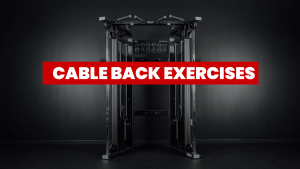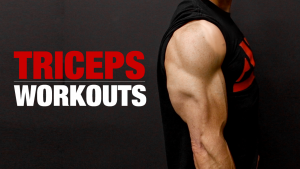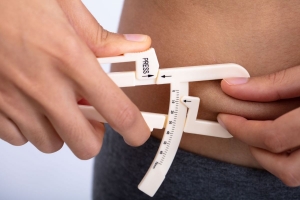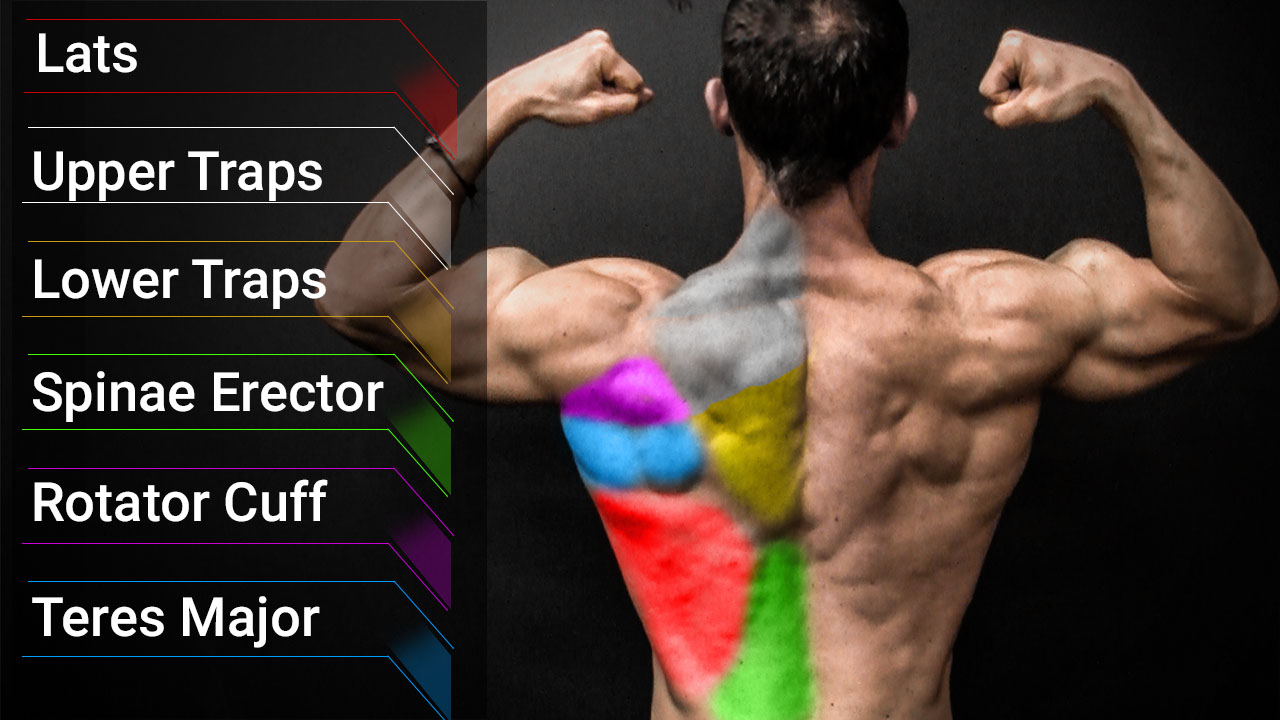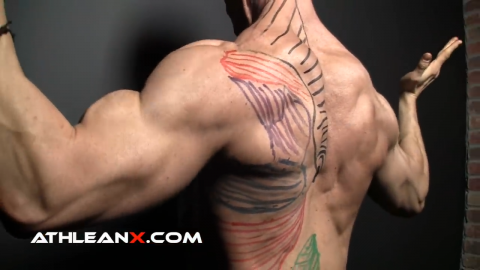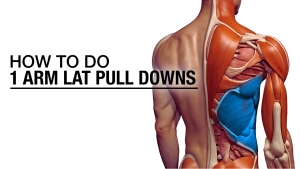
HOW TO PERFORM SEATED CABLE ROWS CORRECTLY
You think you know how to do Seated Cable Rows, but chances are, you’re making at least one of the two most common mistakes.
It’s not just about pulling the cable to your chest – it’s about maximizing every rep to build serious muscle.
If you’ve been mindlessly yanking the cable and wondering why your back isn’t growing like it should, it’s time to rethink your approach.
The Seated Cable Row is one of the best exercises for strength training the back and it should absolutely be included in your routine, but you have to learn to do it right first.
I’m going to cover two of the most important ways you can change up your form to execute a perfect Seated Cable Row every time.
I’ll also breakdown the exercise step by step so you can lift with confidence.
SEATED CABLE ROWS: MUSCLE TARGETED
Building a strong mind-to-muscle connection is a must for maximizing the benefits of your upper-body strength workout.
Understanding which muscles are engaged during the Seated Cable Row can significantly enhance your performance and results.
Let’s dive into the major muscle groups targeted by this raw power movement.
The major muscle groups that are activated during the Seated Cable Row are the posterior chain muscles.
LATISSIMUS DORSI
The lats – or latissimus dorsi muscles, if we’re getting technical – are the heavy hitters of your back.
They span a significant portion of your lower and mid-back, giving you that impressive “wing-like” appearance when flexed.
These primary muscles start from your spine, fan out, and attach to the side of your upper arm bone (the humerus).
They play a key role in several movements:
Shoulder Extension: This involves bringing your arm down from a raised position or pushing it backward, like when you’re performing Pull-Ups or swimming.
Shoulder Adduction: This brings your arm closer to your body (think of flapping your arms like a bird).
Internal Rotation: This occurs when you turn your arms inward.
To effectively engage your lats, incorporate exercises like the Lat Pulldown, perfect for shoulder extension and adduction, and the Dumbbell Pullover, another great move for targeting these muscles.
Additionally, try variations like the Single-Arm Cable Row, which enhances muscle activation and corrects imbalances, and the Wide Grip Seated Cable Row to intensely target the upper back and rear deltoids.
These exercises will help maximize muscle stimulation and ensure well-rounded development of your strong latissimus dorsi muscles.
UPPER AND LOWER TRAPEZIUS


When diving into the back muscles, don’t overlook the trapezius muscles, or “traps.” Picture them as a diamond draped over your upper back, with upper, middle, and lower portions.
The upper trapezius muscles originate at the base of your skull, extend down the neck, and attach to the collarbone.
When you shrug your shoulders or raise your arms overhead, that’s your upper traps in action.
They’re essential for shoulder and neck alignment, especially during overhead motions. Try exercises like the Standing Rope Cable Row to engage these muscles.
The middle and lower traps start from the mid-spine and anchor on the shoulder blade. They’re engaged when pushing your shoulder blades down or lifting your arms.
For maximum muscle activation, use a Cable Rows alternative like Single-Arm Cable Rows and Wide Grip Seated Cable Rows. These not only target the traps but also help with emphasis to accessory muscles like the rhomboid muscles and rear deltoids.
ERECTOR SPINAE (LOW BACK)


Imagine your spine as the backbone of your back strength, with the erector spinae muscles flanking it like strong, vertical pillars.
These muscles aren’t just a single entity; they’re a robust group of deep muscles and tendons running from the base of your skull down to your lower back and sacrum.
The erector spinae are essential for various movements and maintaining proper posture.
Every time you stand up from a bent-over position or lift your head to look upwards, these muscles are responsible for spinal extension.
When you’re performing Deadlifts or Bent-Over Rows, the erector spinae keep your spine in a neutral position, safeguarding your vertebrae and preventing a stubborn injury.
But their role doesn’t stop there.
These muscles also enable lateral flexion, which is the movement pattern that allows you to bend your trunk to the side. Additionally, they are involved in the rotational movements of the spine, providing stability and flexibility.
To effectively target and strengthen the erector spinae, incorporating a variety of exercises is key. Using a cable machine with different cable attachments, such as a V-grip bar or rope cable row equipment, ensures continuous tension for maximum muscle activation.
TERES MAJOR
Nestled on the backside of your shoulder is the teres major, a small but powerful muscle that acts as the “little helper” to your latissimus dorsi.
To locate it, find your armpit, move towards your spine, and slightly upward. That thick band you feel is the teres major.
This muscle is responsible for the following:
Shoulder Extension: When you pull something towards you, like in rowing exercises, the teres major is at work.
Internal Rotation: During movements like rotating your arm inward, the teres major helps drive this motion.
Adduction: Bringing your arm down from an elevated position to your side engages the teres major.
For targeting the teres major with cables, consider exercises like the Seated Cable Row, which serves as an excellent alternative to Bench Dumbbell Rows.
Using various grips and cable row variations, such as Rope Cable Row variations, can enhance muscle activation.
SHOULDERS
While it’s not one of the primary muscles targeted by the Seated Cable Row, the rear delts still play an important role in helping you execute the movement.
POSTERIOR DELTS (REAR DELTS)
The rear delt muscles are important players in shoulder extension and external rotation, crucial for various upper body movements.
To experience shoulder extension, lift your arm backward in an upward arc. For shoulder external rotation, turn your arm outward, away from your torso.
Strengthening your rear delts not only enhances these movements but also helps in injury prevention by reducing strain on your anterior delts. This can improve posture and shoulder health over time.
When performing the Seated Cable Row, your rear delts are heavily involved.
As you pull the cable towards your torso, these muscles work alongside your upper back muscles and lats to execute the motion efficiently.
Using various grips and cable row variations can further engage and strengthen your rear delts.
One of the most important supporting muscles during the Seated Cable Row is the upper arm muscles known as the biceps.
SHORT HEAD (INNER BICEPS)
Located on the inside upper portion of your upper arm, this muscle contributes significantly to the overall size and peak of your biceps.
It’s not just about aesthetics; the short head of the biceps is essential for various arm and upper body movements.
Elbow Flexion: The short head of the biceps is the primary muscle involved when you bend your elbow. This movement is crucial in exercises like Barbell Curls and Cable Rows, where bending the elbow brings the handle closer to your torso.
Forearm Supination: This muscle plays a key role in rotating your forearm so your palm faces up. Forearm supination is essential in movements like the dumbbell curl and also stabilizes the wrist during pulling movements like Seated Cable Rows.
Shoulder Flexion: The short head helps lift your arm forward, contributing to upper body movements that involve the shoulders. This function is particularly important in the initial phase of the Seated Cable Row, where shoulder flexion assists in the pulling motion.
During Seated Cable Rows, as you pull the cable towards your torso, the biceps contract to flex the elbow.
This action not only engages the biceps but also enhances the activation of stabilizer muscles in the upper arm and shoulder.
LONG HEAD (OUTER BICEPS)

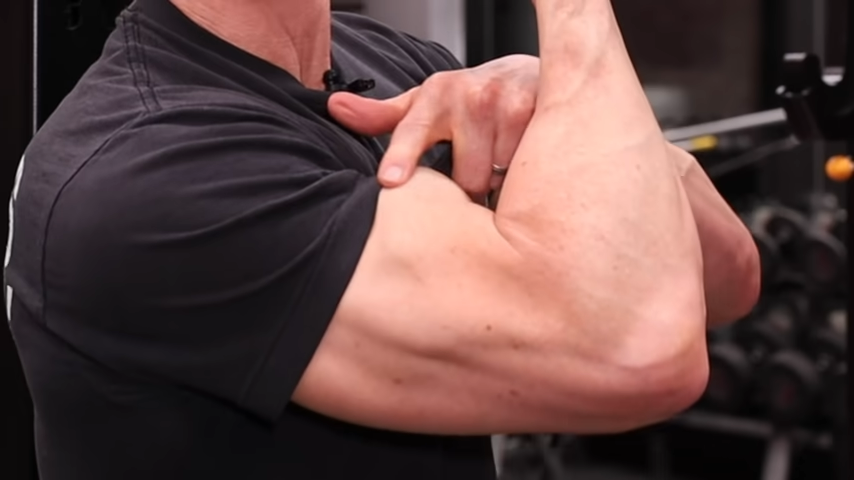
Located on the outer portion of your upper arm, the long head of the biceps significantly contributes to the overall size and shape of your biceps. It’s also involved in a number of upper body movements and functions:
Just like the short head, the long head of the biceps is heavily involved in elbow flexion. This is when you bend the elbow, bringing the handle closer to your torso, engaging the long head intensely.
Additionally, it plays a role in forearm supination, rotating your forearm so your palm faces up.
The long head also assists in shoulder flexion, lifting your arm forward and contributing to upper body movements involving the shoulders, particularly important in the initial phase of the Seated Cable Row to help initiate the pulling motion.
HOW TO DO THE SEATED CABLE ROW
If you’re looking to build a thick, strong back, the seated cable row should be a staple in your routine.
This move keeps your torso stable while engaging your mid-back muscles with constant tension, making it a fantastic compound exercise for overall back development.
Think of it as the Barbell Row’s versatile cousin, delivering the same muscle activation but with the added bonus of continuous resistance.
Ready to perfect your form and maximize your gains?
Let’s start with the two best tips for proper form.
Here are two tips you can use right away that will make a noticeable difference the next time you do a row.
You should be able to feel the improvement instantly.
MINIMIZE BICEPS / FOREARMS CONTRIBUTION
When you’re rowing, your body naturally tries to use as many pulling muscles as possible, including your biceps and forearms, which can reduce the effectiveness of your back muscles.
To counter this, minimize the contribution of your biceps and forearms by adjusting your wrist position.
Start by bending your wrists back slightly.
This prevents your forearms and wrist flexors from initiating the pulling movement, keeping the load on your back muscles.
By maintaining your wrists in this bent-back position, you’ll force your lats to do more of the work.
Focus on leading with your elbows as you row, which helps engage your lats and upper back muscles more effectively.
You should feel your lats doing much more of the work compared to when your wrists are in a neutral or forward-curling position.
When you use a standard grip on the bar grip attachment or dumbbells, keep your wrists slightly extended throughout the movement.
This simple adjustment ensures greater activation of your back muscles, making your rowing exercises more effective. Try this technique, and you should notice an immediate improvement.
RETRACT YOUR SHOULDER BLADES
The second tip focuses on strengthening a key muscle group: the rhomboids, located between your shoulder blades.
If you want your lats to work as effectively as possible, you need to provide them with a stable platform.
Think of it like trying to jump off a balloon versus a solid surface—you can generate more force from a stable base.
Before performing any rowing movement, make sure to set your scapula properly.
Pull your shoulder blades back and together without bending your elbows.
This creates a stable platform, allowing your lats to generate more force.
By setting your scapula before you row, you’ll notice that your lats engage more effectively, resulting in better muscle activation and growth.
Incorporate this technique in your rowing exercises to maximize your lat development and strength gains.
SEATED CABLE ROWS


HOW TO DO IT THE SEATED CABLE ROW:
- Sit at a cable row machine with a weight stack that matches your strength level.
- Secure the cable attachment and choose your handle – V-handle, straight bar, or rope cable attachment. Your grip attachment can vary, but maintaining a strong, stable grip is crucial.
- Sit with your feet flat on the platform and your knees slightly bent. Keep your chest up, shoulders back, and down, avoiding any rounding of the shoulders. This optimal position stabilizes your scapula, ensuring proper muscle engagement.
- Take a firm grip on the handle. Don’t use a narrow grip here. Opt for a more neutral grip in the middle of the bar. To minimize the contribution of your biceps and forearms, bend your wrists back slightly. This prevents your forearms and wrist flexors from initiating the pull, keeping the load on your back muscles.
- Maintain your wrists in this bent-back position throughout the movement.
- Before you start pulling, set your scapula by pulling your shoulder blades back and together without bending your elbows. This creates a stable platform, allowing your lats to generate more force.
- Imagine trying to hold a pencil between your shoulder blades to ensure maximum contraction.
- Begin the movement by retracting your scapula and squeezing your shoulder blades together as you drive your elbows back. Focus on engaging your back muscles, particularly the latissimus dorsi.
- As you pull the handle towards the lower part of your ribs, lead with your elbows to maximize muscle engagement.
- On the way back out, resist the weight stack slowly. Don’t just let it drop.
- The eccentric phase is crucial for muscle growth as it places the muscles under tension. Control the motion to maintain tension on the muscles throughout the exercise.
WHAT MAKES IT EFFECTIVE: One of the best compound exercises for your back, the Seated Cable Row, is a must-have for any upper body workout program. It keeps your torso locked in place while you retract your shoulder blades, putting constant tension on your mid-back. It’s like the Barbell Row, hitting all the same muscle groups but with the added benefit of continuous tension. If you’re new to the exercise, consider a beginner-friendly Seated Cable Row alternative exercise by performing the movement with resistance bands.
SEATED CABLE ROW: COMMON MISTAKES
Mastering the Seated Cable Row is crucial for maximizing muscle growth and avoiding injuries.
However, there are several common mistakes that can hinder your progress and put you at risk for injury.
Let’s break down these pitfalls and how to avoid them.
ROUNDING THE SHOULDERS
One of the biggest mistakes is letting your shoulders round forward.
This not only reduces the effectiveness of the exercise but also puts unnecessary strain on your upper back muscles and can lead to a nagging injury.
Always keep your chest up, shoulders back, and maintain a neutral position.
This optimal position stabilizes your scapula, ensuring proper muscle engagement and reducing the risk of shoulder injuries.
Maintaining good form with abs engaged is essential for a safe and effective workout.
USING TOO MUCH WEIGHT
I see too many guys prioritizing weight over form when performing this exercise.
While it’s tempting to stack on heavier weights to build Barbell Row strength, this can compromise your form and increase the risk of injury.
Focus on using a lighter weight stack that allows you to perform the exercise with proper technique, ensuring maximum muscle activation.
This approach is vital for long-term growth of muscle cells and overall upper body strength.
Ditch your ego and opt for light weight, slowly building up in the weight plate numbers.
Weight trainers should prioritize lower weight with quality reps instead of simply lifting heavier weights.
INCORRECT GRIP
Your grip attachment matters. Using the wrong grip can shift the emphasis away from the primary muscle groups you’re targeting.
Whether you choose a V-handle, straight bar, or rope cable row substitute, ensure it aligns with your goal of engaging the latissimus dorsi and stabilizer muscles.
Experiment with underhand grip, wide grip, and neutral grip to find the most effective grip for your body and strength training routine.
LACK OF SCAPULAR RETRACTION
Failing to retract your scapula can diminish the effectiveness of the Seated Cable Row.
Initiate the movement by pulling your shoulder blades together, ensuring that the emphasis is on the back muscles.
This is critical for engaging the primary muscle and promoting the growth of muscle cells.
Scapular retraction helps with maximum muscle stimulation and ensures that accessory muscles, such as the rhomboids and rear deltoids, are also activated.
POOR RANGE OF MOTION
A full range of motion is essential for muscle development. Avoid short, choppy movements.
Fully extend your arms and pull the handle all the way to your torso, ensuring that the entire range of motion is utilized.
This helps in activating the largest muscle groups in the back effectively.
Proper range of motion might also prevent stubborn injuries and enhance overall muscle density.
NEGLECTING THE ECCENTRIC PHASE
Don’t just focus on the pull. The eccentric phase, where you resist the weight stack as you let the handle return to the starting position, is crucial for muscle growth.
Control the motion to maintain weight under tension on the muscles throughout the exercise.
This eccentric phase is key for muscles because it helps in the growth of muscle cells and improving muscle strength under tension.
IMPROPER BODY POSITION
Maintaining the optimal position is important. Sit upright with your abs engaged to support your lower back.
Leaning too far forward or backward can throw off your form and reduce the efficiency of the movement.
Ensure your row form keeps your back straight and your core engaged to prevent injuries and maintain proper muscle activation.
NOT EXPLORING ALTERNATIVES
Sticking to the same routine can lead to plateaus. Incorporate Cable Row alternatives like 1-Arm Cable Rows or Rope Cable Row variations to target stabilizer muscles and secondary muscle groups.
These variations can provide a fresh stimulus and enhance your upper body strength.
Exploring alternatives to Traditional Cable Rows, such as Traditional Barbell Rows or Dumbbell Rows, can also diversify your push-pull strength training routine and contribute to comprehensive upper-body strength.
By avoiding these common mistakes, you can ensure that your Seated Cable Row technique is solid, maximizing the benefits of this excellent cable exercise.
Remember, quality over quantity: focus on proper form, controlled movements, and engaging the correct muscles to achieve the best results in your upper body strength training routine.
Incorporate different grip attachments, emphasize scapular retraction, and maintain a full range of motion to enhance muscle growth and overall strength.
Guys, the Seated Cable Row should absolutely be a part of your upper body workouts, but only if you’re doing it right.
Remember to start the movement by bending those wrists back and bracing your scapula. This will ensure perfect form for each and every rep.
If you’re looking for a training program that covers every muscle in the body as well as the back, we’ve got you covered. Check out our ATHLEAN-X programs to see which is the best fit for your goals and fitness level.

- The Seated Cable Row is one of the most effective exercises for targeting several major muscle groups in the posterior chain while helping you build a stronger and bigger back.
- Here’s how to perform the Seated Cable Row:
- Select a weight stack that matches your strength level. Secure your preferred handle: V-handle, straight bar, or rope attachment.
- Sit with feet flat on the platform, knees slightly bent. Keep your chest up, shoulders back and down. Avoid rounding your shoulders to stabilize your scapula for proper muscle engagement.
- Firmly grip the handle. Bend your wrists back slightly to minimize biceps and forearm involvement. Maintain this wrist position throughout the movement.
- Pull the shoulder blades back and together without bending elbows. Create a stable base for your lats to generate more force. Imagine holding a pencil between your shoulder blades for maximum contraction.
- Retract your scapula and squeeze shoulder blades as you drive elbows back. Focus on engaging back muscles, especially the latissimus dorsi.
- Pull the handle towards the lower part of your ribs, leading with elbows.
- Resist the weight stack slowly on the way back out. Control the motion to maintain tension on the muscles.
- Remember, the eccentric phase is crucial for muscle growth.
SEATED CABLE ROWS FAQS
The Seated Cable Row is an effective exercise for targeting multiple muscle groups in your back, making it a staple in any effective upper body workout routine.
Let’s break down which muscles see the most muscle activation during this movement:
Latissimus Dorsi: These are the heavy hitters of your back, spanning a large portion of your lower and mid-back. They play a crucial role in shoulder extension, adduction, and internal rotation.
Trapezius: Both the upper and lower portions are activated, with the upper traps engaging when you shrug your shoulders and the lower traps when you pull your shoulder blades down.
Rhomboids: Located between your shoulder blades, these muscles help retract the scapula, giving you that tight squeeze at the end of the row.
Erector Spinae: These muscles run along your spine and help maintain a neutral position during the row, crucial for preventing a nagging injury.
Posterior Deltoids: These shoulder muscles assist in pulling your arms back and provide stability throughout the movement.
Biceps: While not the primary focus, your biceps act as a secondary muscle, helping with elbow flexion during the pull.
To get the most out of your Seated Cable Row, ensure your form with abs engaged and maintain a neutral position throughout the movement. Start with a weight stack that allows you to focus on proper row form without overloading your stabilizer muscles.
Absolutely, Seated Cable Rows are one of the most effective exercises for building a strong, well-developed back.
They primarily target the latissimus dorsi, the largest muscle in your back, helping you achieve that impressive "V" shape.
Additionally, they engage the trapezius, rhomboids, and posterior deltoids, enhancing upper back strength and posture.
The exercise also activates stabilizer muscles like the erector spinae and core muscles, which are important for maintaining a neutral spine and preventing injury.
The continuous tension provided by the cable setup maximizes muscle growth, while the versatility of grip attachments allows you to target different muscle groups.
Variations like the Single-Arm Cable Row and Standing Rope Cable Row offer alternative to Cable Rows that prevent muscle imbalances and add core stabilization.
Proper execution with a tight core and controlled movements enhances muscle density and growth.
While the Seated Cable Row primarily targets your back muscles, it also engages your shoulders to some degree, particularly the posterior deltoids.
This exercise helps with shoulder extension and external rotation, making it beneficial for overall shoulder stability and strength.
The rear delts work as stabilizer muscles, ensuring proper scapular retraction and enhancing shoulder health.
So, while it's not solely a shoulder exercise, the Seated Cable Row effectively contributes to stronger, more stable shoulders.
Choose horizontal cable machines with a weight stack that matches your strength level. Secure the cable attachment and choose your handle—V-handle, straight bar, or rope cable attachment. Your grip attachment can vary, but maintaining a strong, stable grip is crucial.
Sit with your feet flat on the platform and your knees slightly bent. Keep your chest up, shoulders back, and down, avoiding any rounding of the shoulders. This optimal position stabilizes your scapula, ensuring proper muscle engagement.
Take a firm grip on the handle and bend your wrists back slightly to minimize the contribution of your biceps and forearms. This prevents your forearms and wrist flexors from initiating the pull, keeping the load on your back muscles. Maintain your wrists in this bent-back position throughout the movement.
Before you start pulling, set your scapula by pulling your shoulder blades back and together without bending your elbows. This creates a stable platform, allowing your lats to generate more force. Imagine trying to hold a pencil between your shoulder blades to ensure maximum contraction.
Begin the movement by retracting your scapula and squeezing your shoulder blades together as you drive your elbows back. Focus on engaging your back muscles, particularly the latissimus dorsi.
As you pull the handle towards the lower part of your ribs, lead with your elbows to maximize muscle engagement.
On the way back out, resist the weight stack slowly. Don’t just let it drop. The eccentric phase is crucial for muscle growth as it places the muscles under tension. Control the motion to maintain tension on the muscles throughout the exercise.
REFERENCES

Jeff Cavaliere M.S.P.T, CSCS
Jeff Cavaliere is a Physical Therapist, Strength Coach and creator of the ATHLEAN-X Training Programs and ATHLEAN-Rx Supplements. He has a Masters in Physical Therapy (MSPT) and has worked as Head Physical Therapist for the New York Mets, as well as training many elite professional athletes in Major League Baseball, NFL, MMA and professional wrestling. His programs produce “next level” achievements in muscle size, strength and performance for professional athletes and anyone looking to build a muscular athletic physique.






